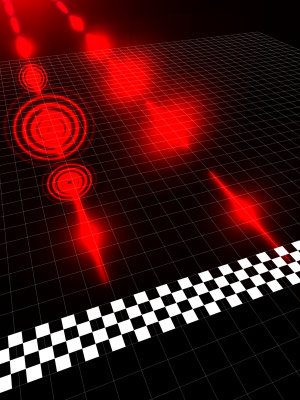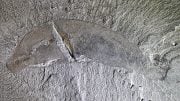
Researchers have successfully slowed down photons in free space by applying a mask to an optical beam, giving the photons a spatial structure. Credit: University of Glasgow
By applying a mask to an optical beam to give photons a spatial structure, physicists have demonstrated that spatially structured photons travel slower than the speed of light in free space.
Scientists have long known that the speed of light can be slowed slightly as it travels through materials such as water or glass.
However, it has generally been thought impossible for particles of light, known as photons, to be slowed as they travel through free space, unimpeded by interactions with any materials.
In a new paper published in Science Express, researchers from the University of Glasgow and Heriot-Watt University describe how they have managed to slow photons in free space for the first time. They have demonstrated that applying a mask to an optical beam to give photons a spatial structure can reduce their speed.
Their experiment was configured like a race, with two photons released simultaneously across identical distances towards a defined finish line.
The team compares a beam of light, containing many photons, to a group of cyclists who share the workload by taking turns cycling at the front. Although the group travels along the road as a unit, the speed of individual cyclists can vary as they swap positions.
The group formation can make it difficult to define a single velocity for all cyclists, and the same applies to light. A single pulse of light contains many photons, and scientists know that light pulses are characterized by a number of different velocities.
The researchers found that one photon reached the finish line as predicted, but the structured photon which had been reshaped by the mask arrived later, meaning it was traveling more slowly in free space. Over a distance of one meter, the team measured a slowing of up to 20 wavelengths, many times greater than the measurement precision.
The work demonstrates that, after passing the light beam through a mask, photons move more slowly through space. Crucially, this is very different from the slowing effect of passing light through a medium such as glass or water, where the light is only slowed during the time it is passing through the material – it returns to the speed of light after it comes out the other side. The effect of passing the light through the mask is to limit the top speed at which the photons can travel.
The work was carried out by a team from the University of Glasgow’s Optics Group, led by Professor Miles Padgett, working with theoretical physicists led by Stephen Barnett, and in partnership with Daniele Faccio from Heriot-Watt University.
Daniel Giovannini, one of the lead authors of the paper, said: “The delay we’ve introduced to the structured beam is small, measured at several micrometers over a propagation distance of one meter, but it is significant. We’ve measured similar effects in two different types of beams known as Bessel beams and Gaussian beams.”
Co-lead author Jacquiline Romero said: “We’ve achieved this slowing effect with some subtle but widely-known optical principles. This finding shows unambiguously that the propagation of light can be slowed below the commonly accepted figure of 299,792,458 meters per second (670,616,629 mph), even when traveling in air or vacuum.
“Although we measure the effect for a single photon, it applies to bright light beams too. The effect is biggest when the lenses used to create the beam are large and when the distance over which the light is focused is small, meaning the effect only applies at short range.”
Professor Padgett added: “It might seem surprising that light can be made to travel more slowly like this, but the effect has a solid theoretical foundation and we’re confident that our observations are correct.
“The results give us a new way to think about the properties of light and we’re keen to continue exploring the potential of this discovery in future applications. We expect that the effect will be applicable to any wave theory, so a similar slowing could well be created in sound waves, for example.”
The team’s paper, titled ‘Spatially Structured Photons that Travel in Free Space Slower than the Speed of Light’, is published in Science Express, which provides electronic publication of selected papers in advance of print in the journal Science.
Reference: “Spatially structured photons that travel in free space slower than the speed of light” by Daniel Giovannini, Jacquiline Romero, Václav Potoček, Gergely Ferenczi, Fiona Speirits, Stephen M. Barnett, Daniele Faccio and Miles J. Padgett, 22 January 2015, Science.
DOI: 10.1126/science.aaa3035









Light travels in slightly lesser speed than in vacuum in denser medium like Air, Gases ,Water, liquids and glass and this is given by the Refractive Index Sine formula. But in free medium, it is supposed to travel in the same speed. If the wavefront is obstructed when travelling from denser to rarer medium and vice versa the same wavefront will be subject to some strain during ordinary reflection and diffraction (Bending around the corners) also. The same physical law justifies the impedance of the speed of photons in this case also. Thank You.
I agree with Madanagopal.V.C. I also don’t think it is a new finding at all, ‘old wine in new bottle’. Who did slow down the speed, scientists or something else – the cause of the phenomenon?